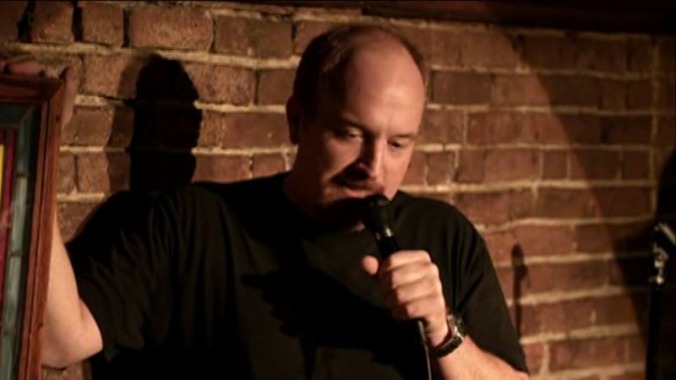Visiting the Comedy Cellar, the New York hub of Louie’s expanding universe
In the eyes of the viewing public and the voting bodies behind various TV accolades, Louie is a situation comedy—a situation comedy that challenges the conventions of the form, certainly, but one that is still predicated on episodic storytelling in which character + new scenario = laughs. Nervous laughs, painful laughs, knowing laughs because viewers have found themselves in a similar position and done the polite (i.e. non-Louie) thing—but laughs nonetheless.
But with its varying methods of filmmaking, its tendency to delve into the deeply absurd and/or tragically dramatic, and its loose relationship to continuity, Louie can be a different show from one week to the next. By working cheaply (and largely on his own), creator-star-writer-director-editor Louis C.K. set up a TV sandbox for himself, one that grants him 13 chances to make a different short film (or two different short films) per season—short films set in the same universe and employing a recurring cast of characters who deal with a rotating crop of topics and themes. Love, divorce, masculinity, depression, loneliness, success, fatherhood, dating, drinking, smoking, drugs, the elderly, motorcycle accidents, singing in the car, Woody Allen fetishism, the largely untapped comedic skills of David Lynch—the list goes on.
To encompass all of these factors, C.K. hasn’t limited himself to, say, the traditional sitcom setup of his short-lived HBO series, Lucky Louie. Certain attributes mark this Louie as a situation comedy, but at times, the show feels more like an anthology series, a comedic Twilight Zone where C.K. is both Rod Serling and the poor dope trapped in Serling’s latest flight of fancy. When C.K.’s onscreen alter ego is pining over/lusting after Pamela Adlon or chasing a daffy Parker Posey across New York City, Louie is a romantic comedy. When the series sends Louie on an overseas USO tour, it’s briefly an intimate military drama. And for 60 seconds of nearly every episode, as the camera follows Louie up the stairs from the West Fourth Street—Washington Square Subway station, down the streets of Greenwich Village, and then back underground to the cozy confines of the Comedy Cellar, Louie is a workplace sitcom.
The Comedy Cellar is the spoke around which Louie’s universe spins. In the real world, it’s been the hive of comedy activity in the Village for 31 years, hosting performances by Andy Kaufman and Robin Williams in its early days, then fostering a band of up-and-coming regulars, six of whom are now enshrined behind Plexiglas near the club’s interior entrance: Ray Romano, Dave Chappelle, Jon Stewart, Wanda Sykes, Darrell Hammond, and Colin Quinn. Speaking with The A.V. Club about C.K.’s choice to include the Comedy Cellar as one of his show’s bases of operation, longtime collaborator and Louie producer M. Blair Breard spoke of the venue in terms of its comforts and homeyness. There’s a lived-in quality to this “comedian’s comedy club,” a communal charm broadcast by the messages scrawled on the framed headshots that line its hallways.
From the late Mitch Hedberg, addressing booker Estee Adoran: “To Estee from Mitch. Thank you for being my friend.”
Anthony Jeselnik’s address cuts through his caustic onstage persona: “Thank you for being my family.”
Meshing well with Sarah Silverman’s message informing the club she’s pregnant (“It’s yours”), C.K.’s is one of the many tongue-in-cheek memos on the wall: “I’m going to hate looking at this picture all the time. Please take it down when I die.”
And when he writes “all the time,” he means “all the time.” In addition to being the most familiar of Louie’s regular settings (with the possible exception of Louie’s apartment), the Comedy Cellar is where the real-life C.K. goes to hash out new material, walking to each gig along the same path laid out under the show’s opening credits. Breard said the production gives no advance warning when Louie drops in, a practice that’s in line with the surprise visits paid to the club by the likes of C.K., Chappelle, Chris Rock, and other giants of stand-up. For the audience, that’s part of the thrill of attending a show at the Comedy Cellar; for the comedians—who, the night before The A.V. Club visited the Comedy Cellar, included Amy Schumer, John Mulaney, and Chappelle’s Show co-creator Neal Brennan—it can add a nerve-racking unknown to the proceedings. (As Bill Burr found out the night he was sandwiched between Romano, Rock, Jerry Seinfeld, and Chappelle.)
Louie’s opening sequence—which, like any other facet of the show, has become less of a given as the series’ episode count has increased—follows the comic into his workplace. From there, he can take the viewer anywhere: Afghanistan, China, Miami, Hollywood, Staten Island, up the stairs to the Olive Tree Café. Louie covers an increasingly diverse set of territories, but it all comes back to the Comedy Cellar. The show’s main setting looks like New York City, but Louie really takes place inside Louis C.K.’s head—the portal to which is the small stage in a basement club on Macdougal Street.
